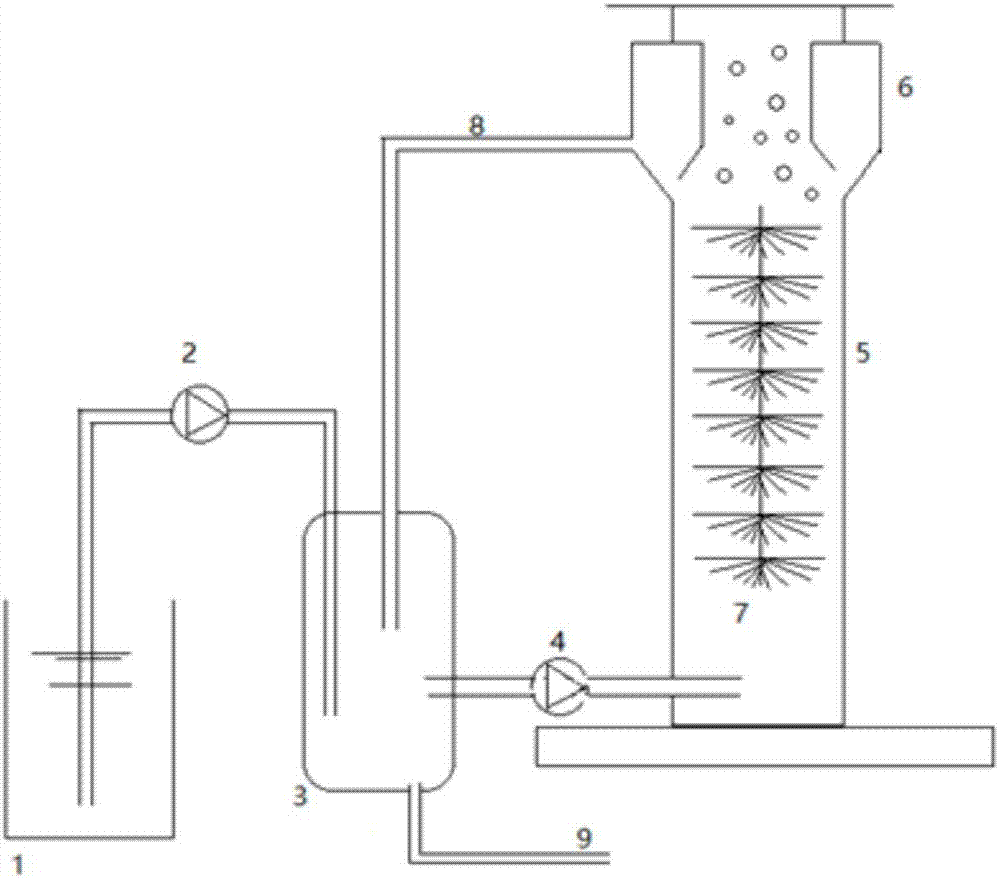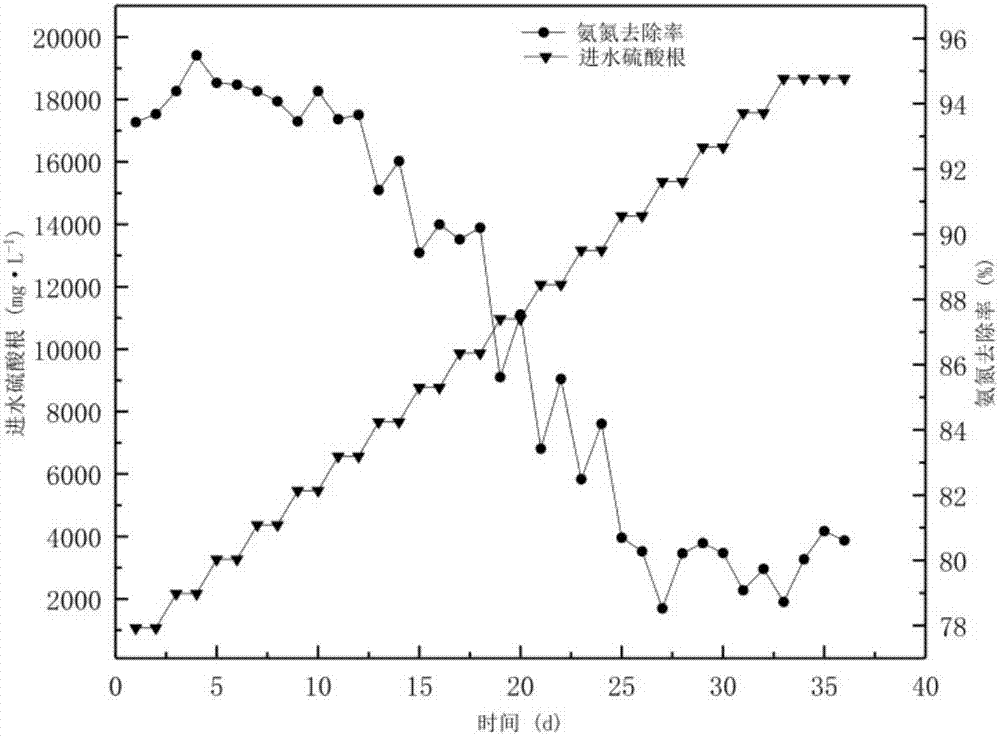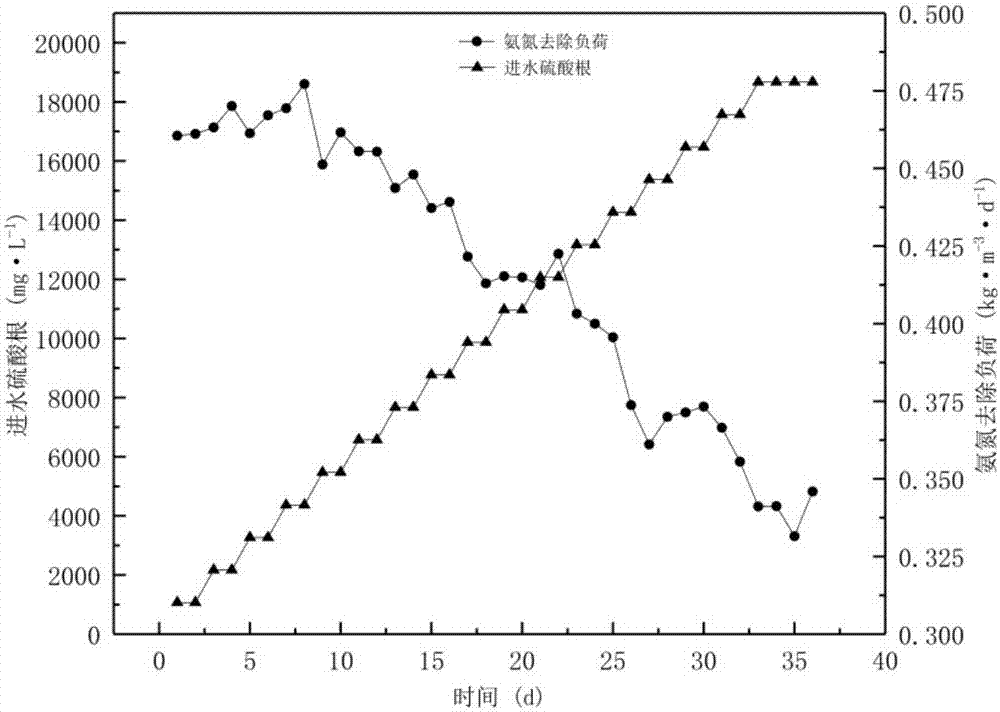Method for domesticating sulfate-resistant type anaerobic ammonium oxidation bacteria
A kind of anammox bacteria and anaerobic ammonium oxidation technology, applied in chemical instruments and methods, methods using microorganisms, food industry wastewater treatment, etc., can solve the problems of long domestication period and poor sludge stability, and achieve low ammonia nitrogen Concentration, efficient denitrification, enhanced activity and adaptability
- Summary
- Abstract
- Description
- Claims
- Application Information
AI Technical Summary
Problems solved by technology
Method used
Image
Examples
Embodiment 1
[0033] The red granular anammox sludge was used as seed sludge for domestication. The inoculum amount of the sludge is 3.5L, and the MLSS of the sludge is 9000mg / L. The activated sludge is added to the reactor from the top of the reactor, and the reactor is sealed. The artificially simulated wastewater was used to start the experiment, and the concentration of ammonium sulfate was 1.47g / L (NH 4 + -N concentration is 200mg / L, SO 4 2-Concentration is 1067mg / L). Sodium nitrite artificial wastewater mainly provides nitrogen, trace elements and macroelements necessary for microbial growth. The pH of the influent water is adjusted at 7.5, the water temperature is adjusted to 31±1°C, and the concentration of sodium bicarbonate is controlled at 1500mg / L. High-purity nitrogen gas needs to be introduced into the bucket for storing artificial wastewater to completely dissolve the agent and blow out the dissolved oxygen.
[0034] The reactor uses a UASB reactor with reflux and thre...
Embodiment 2
[0037] Except that the dosage of sodium sulfate is increased to 3g / L each time, other conditions are kept the same as in Example 1 until the sulfate radical concentration in the influent is 18000mg / L. The total nitrogen removal rate, Heme c content and 16s rRNA copy number were measured when sodium sulfate was stopped.
Embodiment 3
[0039] Except that the dosage of sodium sulfate is increased by 5g / L each time, other conditions are kept the same as in Example 1 until the sulfate radical concentration in the influent is 18000mg / L. The total nitrogen removal rate, Heme c content and 16s rRNA copy number were measured when sodium sulfate was stopped.
[0040] When the addition of sodium sulfate was stopped, see Table 1 for the comparison of the total nitrogen removal rate, Heme c content and 16s rRNA content of the three implementation cases.
[0041] Table 1 When the addition of sodium sulfate is stopped, the total nitrogen removal rate, Heme c content and 16s rRNA content comparison of the three implementation cases
[0042]
[0043] In the three examples, from Example 1 to Example 3, the total nitrogen removal rate increases gradually, from 53.1% to 78.2%, which is an increase of 47.18%, which proves that the effect of the domestication method described in this patent is relatively good. The content o...
PUM
| Property | Measurement | Unit |
|---|---|---|
| Tolerance | aaaaa | aaaaa |
Abstract
Description
Claims
Application Information
 Login to View More
Login to View More - R&D
- Intellectual Property
- Life Sciences
- Materials
- Tech Scout
- Unparalleled Data Quality
- Higher Quality Content
- 60% Fewer Hallucinations
Browse by: Latest US Patents, China's latest patents, Technical Efficacy Thesaurus, Application Domain, Technology Topic, Popular Technical Reports.
© 2025 PatSnap. All rights reserved.Legal|Privacy policy|Modern Slavery Act Transparency Statement|Sitemap|About US| Contact US: help@patsnap.com



